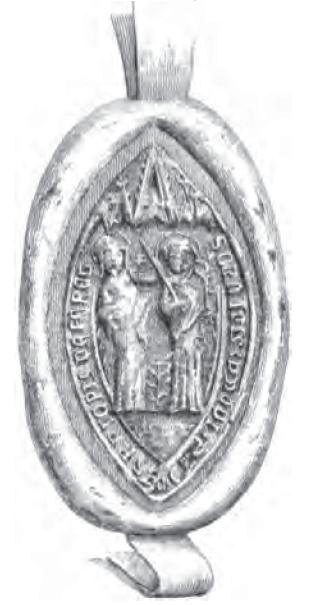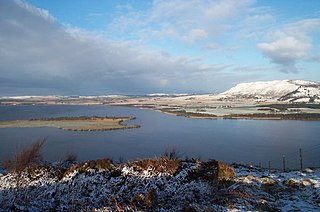
Donnchadh was a Gall-Gaidhil prince and Scottish magnate in what is now south-western Scotland, whose career stretched from the last quarter of the 12th century until his death in 1250. His father, Gille-Brighde of Galloway, and his uncle, Uhtred of Galloway, were the two rival sons of Fergus, Prince or Lord of Galloway. As a result of Gille-Brighde's conflict with Uhtred and the Scottish monarch William the Lion, Donnchadh became a hostage of King Henry II of England. He probably remained in England for almost a decade before returning north on the death of his father. Although denied succession to all the lands of Galloway, he was granted lordship over Carrick in the north.
The Diocese of Aberdeen was originally believed to be the direct continuation of an 11th-century bishopric at Mortlach in present-day Moray. However, this early date and also the first bishops were based on a misinterpretation and reliance on early charters found in the cartulary of Aberdeen Cathedral that are now known to be false. The first recorded bishop of the diocese was Nectan, who was mentioned in the Book of Deer around 1132. The first direct written evidence of a bishop in Aberdeen is found in a papal bull addressed to Bishop Edward in 1157. This bull acknowledges the existence of his cathedral, discusses the formation of a chapter, and marks the start of the expansion of the diocesan structure.

The Abbot and then Commendator of Culross was the head of the monastic community of Culross Abbey, Fife, Scotland. The abbey was founded in 1218 on the patronage of Maol Choluim I, Earl of Fife by Cistercian monks from Kinloss Abbey, Moray. Control of the abbey was secularized in the 16th century and after the accession of James Stewart, the abbey was held by commendators. The number of monks under the abbot had also declined by the 16th century, there being only 15 monks by 1557.
The Prior of St Andrews was the head of the property and community of Augustinian canons of St Andrews Cathedral Priory, St Andrews, Fife, Scotland. It was established by King David I in 1140 with canons from Nostell Priory, West Yorkshire. It is possible that, initially at least, the prior of St Andrews was subordinate to the bishop as abbot, but by the 13th century the canons of St Andrews were given freedom by the bishop to elect their prior. By the end of the 13th century, the abbacy of the native canons was no longer there to challenge the position of the priory, and the native canons themselves had been formed into a collegiate church.
Balmerino Abbey, or St Edward's Abbey, in Balmerino, Fife, Scotland, was a Cistercian monastic community which has been ruinous since the 16th century.
The Prior of Beauly was the head of the Valliscaulian monastic community and lands of Beauly Priory, Beauly, Inverness-shire. It was probably founded in 1230. It became Cistercian on April 16, 1510. The following are a list of priors and commendators:
The Prior of Inchmahome was the head of the community of Augustinian canons at Inchmahome Priory, on Inchmahome in the Lake of Menteith, in Highland Stirlingshire, Scotland. The following is a list of priors and commendators:
The Prior of Oronsay was the Religious Superior of Oronsay Priory, a community of canons regular on the island of Oronsay, Inner Hebrides, off the coast of Scotland. It was in existence by 1353, perhaps founded by John of Islay, Lord of the Isles.
The Abbot of Glenluce was the head of the monastic community of Glenluce Abbey, Galloway. The monastery was founded in 1192 by monks from Dundrennan Abbey with the patronage of Lochlann (Roland), Lord of Galloway. In the 16th century the monastery increasingly came under the control of secular warlords. In 1560 the monastery was occupied by James Gordon of Lochinvar, and the monks were expelled. However, soon after, Thomas Hay, a follower of the earl of Cassillis, was installed in the monastery as commendator and the monks were allowed to return. However, monastic life seems to have disappeared by the end of the century. In 1602 parliament granted the lands of the monastery to Lawrence Gordon as a secular lordship. The abbey was finally given to the bishop of Galloway in 1619. The following is a list of abbots and abbot-commendators:
The Abbot of Crossraguel was the leader of the Cluniac monastic community of Crossraguel Abbey, near Maybole in Carrick, south-west Scotland. It was founded in 1260s by Donnchadh mac Gille Brigte, earl of Carrick with monks from Paisley Abbey. Owing to the lack of surviving records and its distance from the core of Lowland Scotland in the western Gàidhealtachd, few of the abbots are known by name. The abbots were replaced by commendators in the 16th century, and the abbey came to an end when its lands were taken over by the bishops of Dunblane in 1617.
The Abbot of Deer, was the head of the Cistercian monastic community of Deer Abbey in Buchan. It was founded in 1219 by William Comyn, jure uxoris Earl of Buchan. There was an earlier community of Scottish monks or priests which was probably absorbed by the new foundation. It was turned into a secular lordship for Commendator Robert Keith II in 1587. The following is a list of known abbots and commendators:
The Prior of Fogo was the head of the Tironensian monastic community and lands of Fogo Priory, Roxburghshire, founded sometime between 1253 and 1297. The patron was a local landlord named Patrick Corbet, who granted lands to Kelso Abbey to establish a cell there. Although almost none of the priors are known, the following two are recorded:

Lesmahagow Priory was a medieval Tironensian monastic community located in the small town of Lesmahagow in the modern local authority area of South Lanarkshire, Scotland. It was founded after John, Bishop of Glasgow and King David I of Scotland granted lands at Lesmahagow to Kelso Abbey with which to establish a new priory. It remained a dependency of Kelso Abbey. Control of the abbey was gradually secularized in the 16th century. Along with Kelso Abbey, it was turned into a secular lordship in 1607 for Robert Ker of Cesford, later earl of Roxburghe. Lesmahagow passed into the hand of James Hamilton, 2nd Marquess of Hamilton in 1623.
The Prior of Ardchattan was the head of the Valliscaulian, and then Cistercian, monastic community of Ardchattan Priory, Argyll. It was founded in 1230 by Duncan MacDougal, Lord of Argyll. In April 1510 it was incorporated as a cell of Beauly Priory. It was annexed to the bishopric of the Isles in 1615. The following are a list of abbots and commendators:
Odo Ydonc was a 13th-century Premonstratensian prelate. The first recorded appearance of Odo was when he witnessed a charter by Donnchadh, Earl of Carrick, on 21 July 1225. In this document he is already Abbot of Dercongal, incidentally the first Abbot of Dercongal to appear on record.

Perth Charterhouse or Perth Priory, known in Latin as Domus Vallis Virtutis, was a monastic house of Carthusian monks based at Perth, Scotland. It was the only Carthusian house ever to be established in the Kingdom of Scotland, and one of the last non-mendicant houses to be founded in the kingdom. The traditional founding date of the house is 1429. Formal suppression of the house came in 1569, though this was not actualised until 1602.

James Haldenston or James Haldenstoun was an Augustinian churchman from 15th-century Scotland. Probably from somewhere in eastern Fife, Haldenston became an Augustinian at St Andrews, earned several degrees on the continent, and became prior of May before becoming prior of St Andrews, head of the wealthiest and most important religious house in Scotland.

Simon was a 13th-century Augustinian canon based in the Kingdom of Scotland.
Elcho Priory was a medieval Cistercian priory in Perthshire, Scotland, dedicated to the Virgin Mary.
The Minister of South Berwick was the head of the medieval house of non-mendicant Augustinian Trinatarian friars in the Scottish border town of South Berwick. The income of the house was allocated equally towards the upkeep of the brethren, the sustenance of the poor and the poor travellers and the recovery of crusader captives. The house was founded before 1240–8. Each house comprised a minister and five brethren. The names of all of the ministers are incomplete.






